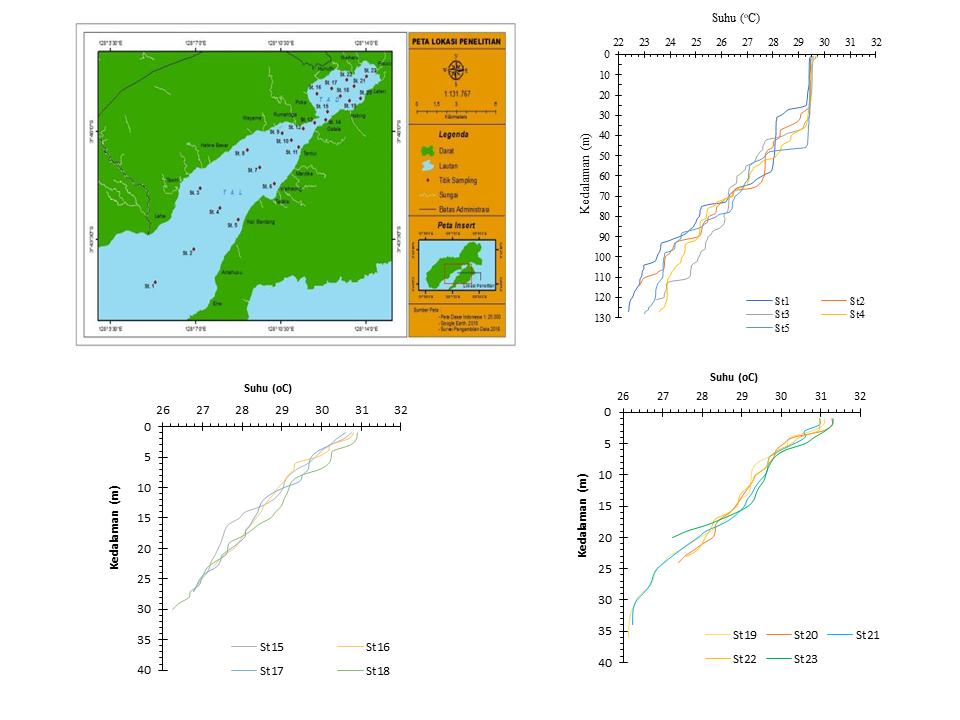Water Mass Characteristic of Ambon Bay based on its Temperature and Chlorophyll-a Distribution
DOI:
https://doi.org/10.46252/jsai-fpik-unipa.2022.Vol.6.No.3.235Keywords:
Ambon Bay, Chlorophyll-a, Sill, Temperature, Water massAbstract
Ambon Bay consists of the inner Ambon Bay (IAB) and the outer Ambon Bay (OAB) and they are separated by the shallow sill (12 m) Galala-Rumah Tiga. The topography of the bay makes it unique and causes the exchange of water mass between those two parts of the bay does not follow the daily tidal cycle. The aim of this study was to analyze the vertical and horizontal temperature and chlorophyll-a distribution in order to know the water circulation in Ambon Bay. This study was carried out during the monsoon, in November 2018. The CTD was used to measure in situ temperature and chlorophyll-a concentration. The data were analyzed by using Surfer and ODV programs. The results show that the temperature of the surface water (0-5 m) of Ambon Bay was 29.2℃. In depth 15-40 m, temperature was different between the IAB (27.7-28.2℃) and OAB (29,2-28.7℃). Chlorophyll-a concentration was found higher in the IAB than in OAB in all depths. In the depth >12 m, chlorophyll-a in the IAB was 1 mg/m3 compared to its concentration in OAB only 0.3 mg/m3. As a conclusion, the sill in Ambon bay causes unique circulation of water mass between IAB and OAB based on the analysis of temperature and chlorophyll-a concentration distribution.
Downloads
References
Anderson, J.J., Sapulete, D. (1982). Deep water renewal in inner Ambon bay, Ambon, Indonesia. In: Gomez, E.D., Birkeland, C.E., Buddemeier, R.W., Johannes, R.E., Marsh Jr., J.A., Tsuda, R.T. (Eds.), The 4th International Coral Reef Symposium. Marine Science Center of University of Philippines, Manila, Phillippines, pp. 369–374.
Bates, B.C., Kundzewicz, Z.W., Wu, S., Palutikof J.P. (2008). Climate Change and Water. Technical Paper of the Intergovernmental Panel on Climate Change. IPCC Secretariat: Geneva
Boyce D.G, Lewis M.R., Worm B. (2010). Global phytoplankton decline over the past Century. Nature 466: 591-596.
Cariou, V., Casotti R., Birrien J.L.,Vaulot D. (1994). The initiation of Phaeocystis colonies. Journal of Plankton Research. 16: 457-470.
Kesaulya, I. (2008). Coupling of Biological and Physical Parameters in two Dimensional Microscales Phytoplankton Distribution. Thesis. Flinders University, Adelaide, South Australia.
Kesaulya, I., Leterme, S.C., Mitchell, J.G., Seuront, L. (2008). The impact of turbulence and phytoplankton dynamics on foam formation, seawater viscosity and chlorophyll concentration in the eastern English Channel. Oceanologia, 50 (2): 167–182
Kesaulya I., Rumohoira D.R., Saravanakumar, A. (2022). The Abundance of Gonyaulax polygramma and Chaetoceros sp. Causing Blooming in Ambon Bay, Maluku. Indonesian Journal of Marine Sciences, 27 (1): 13-19 .
Mitchell, J.G., Fuhrman, J.A. (1989). Centimeter scale vertical hetereogenity in bacteria and chlorophyll a. Marine Ecology Progress Series 54: 141-148
Neelin J.D., Münnich M, Su H, Meyerson J.E., Holloway C.E. (2006). Tropical drying trends in global warming models and observations. Natural Academic. Science103(16): 6110–6115.
Ondara K., Wisha U.J., Rahmawan G.A. (2017). Karakteristik hidrodinamika di perairan teluk Ambon untuk mendukung wisata selam. Jurnal Kelautan 10 (1): 67-77.
Peperzak, L., Colijn F., Vrieling E.G., Gieskes, W.W.C., Peeters, J.C.H., (2000). Observation of flagellates in colonies of Phaeocystis globosa (Prymnesiophyceaae); a hypothesis for their posistion in the life cycle. Journal of Plankton Research 22: 2181-2203.
Powell, T.M., Okubo, A., (1994). Turbulence, diffusion and patchiness in the sea. Philosophical Transactions of the Royal Society B 343: 11-18.
Putri, M.R., Mudjiono, Basit, A. (2008). Monitoring of Physical Oceanography in Ambon Bay (In Indonesian Language). Indonesian Institute of Sciences (LIPI), pp. 41–47. Proceeding PIT ISOI 2008.
Salamena, G.G., Whinney J.C., Heron S.F., Ridd P.V. (2021). Internal tidal waves and deep-water renewal in a tropical fjord: Lessons from Ambon Bay, eastern Indonesia. Estuarine, Coastal and Shelf Science 253: 1-13
Seymour, J.R., Mitchell, J.G., Pearson, L., Waters, R.L. (2000). Heterogeneity in bacterioplankton abundance from 4.5 millimetre resolution sampling. Aquatic Microbial Ecology 22:143-153.
Seymour, J.R., Mitchell, J.G., Seuront, L. (2004). Microscale heterogeneity in the activity of coastal bacterioplankton communities. Aquatic Microbial Ecology 35:1-16.
Solomon, S., Qin, D., Manning, M., Chen, Z., Marquis, M., Averyt, K.B.,Tignor, M., Miller, H.L. (2007). IPCC, 2007: Climate Change 2007: The Physical Science Basis. Contribution of Working Group I to the Fourth Assessment Report of the Intergovernmental Panel on Climate Change.
Staalstrøm A., Røed, L.P. (2016). Vertical mixing and internal wave energy fluxes in a sill fjord. Journal of Marine Systems 159: 15-32.
Tarigan, M.S., Wenno, L.F. (1991). Upwelling in Ambon bay (in Indonesian language). In: Praseno, D.P. (Ed.), Perairan Maluku Dan Sekitarnya Volume. Balai Sumber Daya Laut, P3O LIPI, Ambon, Indonesia, pp. 141–146.
Timbal, B. 2004. Southwest Australia past and future rainfall trends.Clim. Res. 26(3): 233–249
Water, R.L., Mitchell, J.G. (2002). The centimetre-scale spatial structure of estuarine in vivo fluorescence profiles. Marine Ecology Progress Series 237: 51-63
Wenno, L.F., Anderson, J.J. (1984). Evidence for tidal upwelling across the sill of Ambon Bay. Marine Reseaarch Indonesia 23: 13–20.
Wirasatriya, A. (2011). Pola Distribusi Klorofil-a dan Total Suspended Solid (TSS) di Teluk Toli Toli, Sulawesi. Buletin Oseanografi Marina 1: 137 - 149
Yamasaki, H. (1993). Lagrangian study of planktonic organisms: perspectives. Bulletin of Marine Science 53: 265-270.

Downloads
Published
How to Cite
Issue
Section
License
Copyright (c) 2022 Irma Kesaulya, Randy Simaela, Domey L. Moniharapon, Taufuniringsi Kesaulya

This work is licensed under a Creative Commons Attribution-ShareAlike 4.0 International License.


















